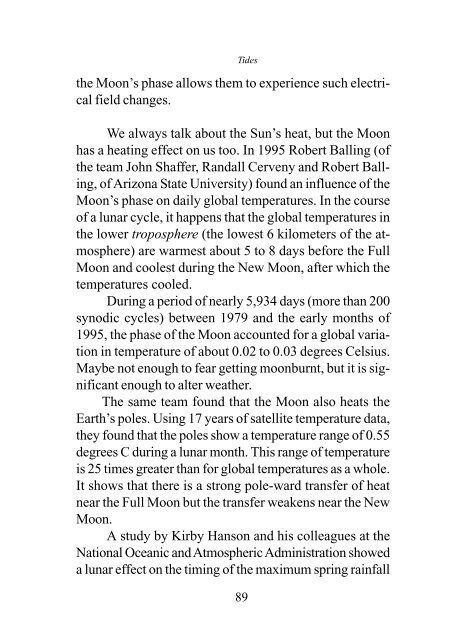Predicting Weather By The Moon - Xavier University Libraries
Predicting Weather By The Moon - Xavier University Libraries
Predicting Weather By The Moon - Xavier University Libraries
Create successful ePaper yourself
Turn your PDF publications into a flip-book with our unique Google optimized e-Paper software.
Tides<br />
the <strong>Moon</strong>’s phase allows them to experience such electrical<br />
field changes.<br />
We always talk about the Sun’s heat, but the <strong>Moon</strong><br />
has a heating effect on us too. In 1995 Robert Balling (of<br />
the team John Shaffer, Randall Cerveny and Robert Balling,<br />
of Arizona State <strong>University</strong>) found an influence of the<br />
<strong>Moon</strong>’s phase on daily global temperatures. In the course<br />
of a lunar cycle, it happens that the global temperatures in<br />
the lower troposphere (the lowest 6 kilometers of the atmosphere)<br />
are warmest about 5 to 8 days before the Full<br />
<strong>Moon</strong> and coolest during the New <strong>Moon</strong>, after which the<br />
temperatures cooled.<br />
During a period of nearly 5,934 days (more than 200<br />
synodic cycles) between 1979 and the early months of<br />
1995, the phase of the <strong>Moon</strong> accounted for a global variation<br />
in temperature of about 0.02 to 0.03 degrees Celsius.<br />
Maybe not enough to fear getting moonburnt, but it is significant<br />
enough to alter weather.<br />
<strong>The</strong> same team found that the <strong>Moon</strong> also heats the<br />
Earth’s poles. Using 17 years of satellite temperature data,<br />
they found that the poles show a temperature range of 0.55<br />
degrees C during a lunar month. This range of temperature<br />
is 25 times greater than for global temperatures as a whole.<br />
It shows that there is a strong pole-ward transfer of heat<br />
near the Full <strong>Moon</strong> but the transfer weakens near the New<br />
<strong>Moon</strong>.<br />
A study by Kirby Hanson and his colleagues at the<br />
National Oceanic and Atmospheric Administration showed<br />
a lunar effect on the timing of the maximum spring rainfall<br />
89





